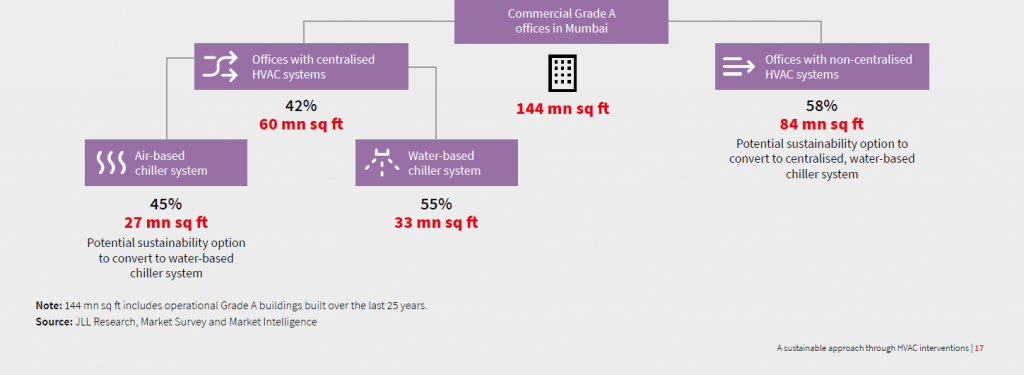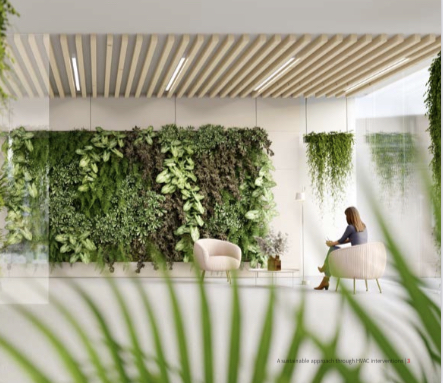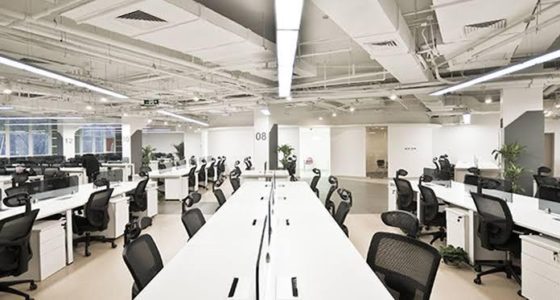Offices in Mumbai can save INR 175 cr power bills annually by switching to greener air conditioning: JLL.
Mumbai has the second largest GHG (Green House Gases) footprint of 22,783.08 Gg (gigagram) in India.
Commercial buildings have a share of 37% of GHG emissions in the city.
39% of any building’s energy is utilized by the Heating, Ventilation, and Air Conditioning (HVAC) system.
By Varun Singh
Mumbai’s Grade A office space currently stands at 144 million sq. ft, of which only 42% (60 million sq ft) uses centralized Heating, Ventilation, and Air Conditioning (HVAC) system which is known as air conditioning system in common parlance. Energy savings by an efficient HVAC system offers long-term solutions for reducing the energy requirements of a commercial building. Within the 60 million sq ft of office space having a centralised HVAC system, only 33 million sq ft uses water-based air conditioning which is more energy-efficient than the air-based counterpart. Due to the use of this water-based cooling system, Mumbai’s office segment is able to save 185 mn Kwh* of energy annually translating into a reduction of 1.48 lakh metric tonnes of CO2 emissions.
The conversion of the balance of 27 million sq ft centralized air-based HVAC to water-based offers the potential to save 152 million Kwh of energy annually. This would lead to an estimated reduction of INR 175 crore on the energy bill annually and a 1.2 lakh metric tonne of carbon emission. These are the major findings of the JLL report titled, “A sustainable approach through HVAC interventions.”

“The type of HVAC technology used by a building is dictated by the climate of the region as well as the availability of power and water. The initial capital outlay also plays a key role. The capital cost for installing a water-based central system is higher than that of an air-based system due to additional equipment like cooling water towers, tanks, and water pumps. However, since water-based chillers are more energy-efficient, the operating benefits outweigh the initial cost outlay in the longer term,” said Rajat Malhotra, APAC head of Engineering operations, Work Dynamics, India, JLL
“It is heartening to note that nearly 23% (33 mn sq ft) of Mumbai’s Grade A office real estate is already utilising the benefits of centralised water-based chiller systems. A transition of those using air-based HVAC systems will double the segment’s energy savings and lead to a reduction in the city’s carbon emissions. This sustainable choice will also support the city’s annual carbon emissions reduction by 1.2 lakh metric tonnes. This upgrade—albeit involving more water consumption—along with added capital investments and technical challenges in existing buildings, will be key components in analyzing the payback period for this change. What is not in question, however, is the definite energy savings and the positive climate impact through a sustained reduction in carbon emissions,” Samantak Das · Chief Economist and Head of Research & REIS at JLL India.

Looking at a greener future
Looking forward, even offices with non-centralized HVAC systems must look at integrating such technology. Costs would be a major concern, not to mention the technical challenges of this switch in already operational buildings. Water consumption will also go up, but this is where the efficiency of the sewage treatment plant (STP) will come into action to ensure that freshwater is not wasted in running HVAC equipment. Importantly, one can upgrade cooling tower dosing systems with modern water treatment technologies and practices to reduce water wastage by cooling tower basins. Owners and operators should not hesitate from investing in treatment technologies sincewater consumption is a critical factor that can place water-based central chillers at a disadvantage, if not managed and controlled through smart operational and maintenance practices. The resultant CAPEX towards such upgrades may act as a deterrent for many asset owners/ investors, but the tangible benefits in terms of operating costs and environmental gains along with energy savings far outweigh the immediate impediments. The payback period will act as the key financial metric, but the tangible environmental benefits will support the switch to this technology in times to come, as India continues its journey to becoming a net-zero carbon economy by 2070.
Also Read: Data Centre industry in India to cross 1.3 GW capacity, grow 2.4X by 2024: JLL









